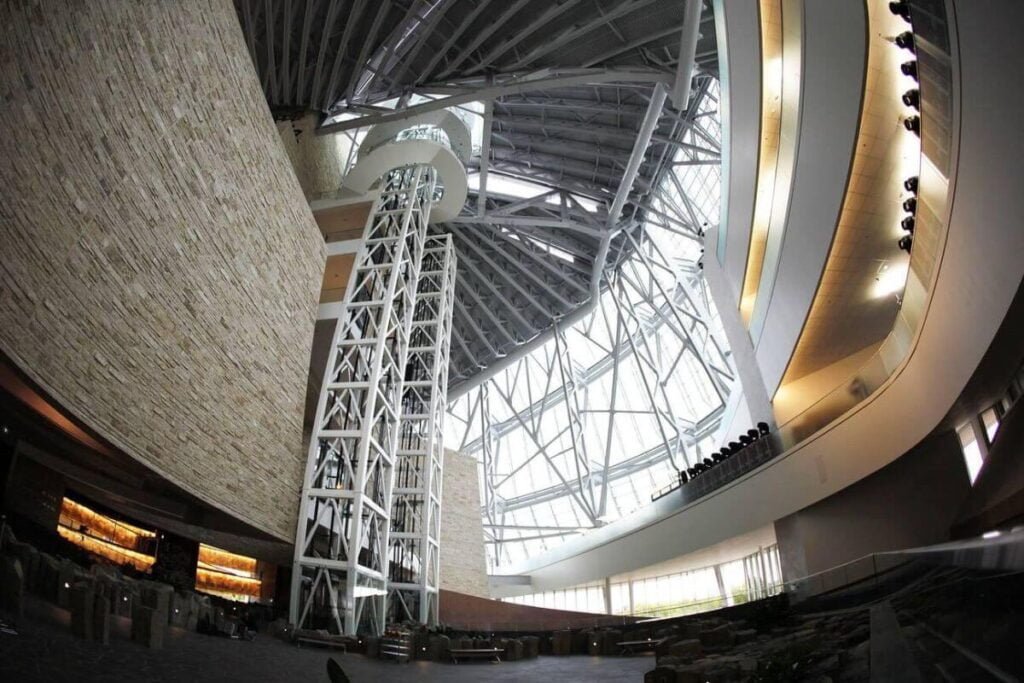History of the Canadian Museum for Human Rights
Founding Vision
The vision for the Canadian Museum for Human Rights originated with the late Israel Asper, a Canadian philanthropist and businessman who believed in the transformative power of education and dialogue. His dream was to create a space where people could learn about human rights, understand their importance, and be inspired to take action. The project received support from various levels of government, private donors, and community organizations, culminating in the establishment of the museum.
Architectural Design
Designed by architect Antoine Predock, the CMHR is a masterpiece of modern architecture. Its striking design includes symbolic elements that reflect the museum’s mission and the journey of human rights. The building’s structure features curved lines, glass walls, and stone elements, creating a dynamic and inspiring environment. The Tower of Hope, a prominent feature, symbolizes the aspiration for a better future.
Opening and Milestones
The Canadian Museum for Human Rights officially opened its doors to the public on September 20, 2014. Since then, it has achieved numerous milestones, including the development of groundbreaking exhibits, the hosting of international conferences, and the establishment of educational programs that reach audiences worldwide. The museum continues to evolve, embracing new technologies and methodologies to enhance its impact.

Exploring the Museum
Overview of Exhibits
The CMHR offers a diverse array of exhibits that cover a wide range of human rights topics. From historical injustices to contemporary struggles, the exhibits are designed to educate, engage, and inspire. Visitors can explore the stories of individuals and communities who have fought for their rights and learn about the ongoing efforts to address human rights violations around the world.
Visitor Experience
The visitor experience at the CMHR is immersive and interactive. The museum employs cutting-edge technology to create engaging displays that allow visitors to interact with the content in meaningful ways. Digital kiosks, multimedia presentations, and virtual reality experiences are just a few of the tools used to bring human rights stories to life.
Interactive Displays
Interactive displays are a hallmark of the CMHR, offering visitors the opportunity to engage directly with the exhibits. Touchscreens, audio guides, and interactive maps provide deeper insights into the topics covered, while hands-on activities encourage visitors to reflect on their own beliefs and actions regarding human rights.
Permanent Exhibits
Indigenous Perspectives
The Indigenous Perspectives exhibit explores the histories, cultures, and rights of Indigenous peoples in Canada and around the world. It highlights the resilience and strength of Indigenous communities, their contributions to society, and the ongoing challenges they face. This exhibit aims to foster understanding and reconciliation by presenting Indigenous voices and stories.
Canadian Journeys
The Canadian Journeys exhibit traces the evolution of human rights in Canada, from early colonial times to the present day. It examines significant events, legislation, and movements that have shaped the country’s human rights landscape. The exhibit also features personal stories and artifacts that illustrate the diverse experiences of Canadians.
Breaking the Silence
Breaking the Silence focuses on genocides and mass atrocities that have occurred around the world. Through powerful narratives and survivor testimonies, this exhibit seeks to educate visitors about the causes and consequences of these horrific events. It also emphasizes the importance of remembrance and the need for ongoing vigilance to prevent future atrocities.
Rights Today
The Rights Today exhibit addresses contemporary human rights issues and challenges. It covers topics such as gender equality, LGBTQ+ rights, freedom of expression, and the impact of technology on human rights. The exhibit encourages visitors to reflect on their role in promoting and protecting human rights in their own communities.
Temporary Exhibits
Recent Highlights
The CMHR regularly hosts temporary exhibits that explore specific themes or contemporary issues in greater depth. Recent highlights have included exhibits on climate change and human rights, the refugee crisis, and the role of art in social justice movements. These temporary exhibits provide fresh perspectives and keep the museum’s content dynamic and relevant.
Upcoming Exhibits
Upcoming exhibits at the CMHR promise to continue the tradition of thought-provoking and engaging content. Planned themes include the impact of artificial intelligence on human rights, the fight against human trafficking, and the history of disability rights movements. These exhibits will offer new opportunities for visitors to engage with current human rights issues.
Special Themes
Special themed exhibits are often developed in collaboration with other museums, cultural institutions, and community organizations. These partnerships allow the CMHR to present diverse perspectives and reach wider audiences. Themed exhibits may also coincide with significant anniversaries, international observances, or cultural celebrations.
Architecture and Design
Building Concept
The architectural concept of the CMHR is deeply symbolic. The museum’s design represents the struggle for human rights and the journey toward a better future. The base of the building, made from Tyndall stone, symbolizes roots and groundedness, while the glass Tower of Hope reaches skyward, representing aspiration and progress.
Symbolism in Architecture
Every element of the museum’s design carries symbolic meaning. The Garden of Contemplation, for example, features water and stone elements that symbolize reflection and resilience. The ramps and bridges throughout the museum represent the ongoing journey toward human rights, while the open spaces invite dialogue and connection.
Sustainability Features
The CMHR is committed to sustainability and environmental stewardship. The building incorporates several green features, such as energy-efficient systems, sustainable materials, and natural lighting. These features reduce the museum’s environmental impact and demonstrate a commitment to sustainable practices.
Educational Programs
Workshops
The CMHR offers a variety of workshops designed to educate and inspire visitors of all ages. These workshops cover topics such as human rights history, advocacy strategies, and the role of art in social justice. Participants can engage in hands-on activities, discussions, and collaborative projects that deepen their understanding of human rights.
School Programs
School programs at the CMHR are tailored to different grade levels and curricula. These programs include guided tours, interactive exhibits, and classroom resources that support teachers in educating students about human rights. The museum also offers virtual programs and digital resources for schools unable to visit in person.
Public Lectures
Public lectures and speaker series at the CMHR feature experts, activists, and scholars who discuss a wide range of human rights topics. These events provide opportunities for visitors to learn from leading voices in the field, engage in meaningful dialogue, and gain new insights into current human rights issues.
Visitor Information
Hours of Operation
The Canadian Museum for Human Rights is open year-round, with varying hours depending on the season. It is advisable to check the official website for the most current hours of operation before planning your visit.
Admission Fees
Admission fees vary by age and category, with discounts available for seniors, students, and groups. Membership options are also available, offering unlimited access and additional benefits. Special pricing may apply during certain exhibits or events.
Accessibility
The CMHR is designed to be accessible to all visitors. The building features ramps, elevators, and accessible restrooms. Additionally, the museum provides services such as sign language interpretation, audio guides, and tactile exhibits to accommodate visitors with different needs.
How to Get to the Museum
By Car
The CMHR is located in downtown Winnipeg and is easily accessible by car. Ample parking is available on-site and in nearby lots. Detailed driving directions and parking information can be found on the museum’s website.
Public Transport
Public transport options include buses and trains that connect the CMHR with other parts of Winnipeg. The museum is a short walk from Union Station, making it convenient for visitors arriving by train. Several bus routes also stop nearby, providing easy access for those using public transportation.
Nearby Attractions
Visitors to the CMHR can also explore nearby attractions such as The Forks, the Exchange District, and the Manitoba Children’s Museum. These sites offer additional cultural and historical experiences that complement a visit to the museum.
Tips for Visiting the Museum
Best Times to Visit
To avoid the busiest times, consider visiting the CMHR during weekday mornings or late afternoons. Off-peak seasons, such as fall and winter, typically see fewer visitors, providing a more relaxed experience.
What to Bring
When visiting the CMHR, it’s a good idea to bring comfortable walking shoes, a camera, and a water bottle. Layered clothing is recommended, as some areas of the museum can be cooler or warmer depending on the weather and season.
Photography Tips
Photography is allowed in most areas of the museum, but flash photography and tripods are generally prohibited. To capture the best images, take advantage of natural lighting, focus on unique architectural details, and explore different angles and perspectives.
The Role of the Museum in Human Rights Education
Community Engagement
The CMHR plays a vital role in engaging the local and global community in human rights education. Through partnerships with schools, community organizations, and cultural institutions, the museum fosters dialogue, understanding, and action on human rights issues.
Global Impact
The museum’s impact extends beyond its physical location, with digital exhibits, online resources, and virtual programs reaching audiences worldwide. The CMHR’s commitment to human rights education and advocacy makes it a global leader in the field.
Partnerships and Collaborations
The CMHR collaborates with various organizations, including other museums, universities, and non-profits, to enhance its educational offerings and extend its reach. These partnerships enable the museum to present diverse perspectives and address a wide range of human rights topics.
Future Plans for the Museum
Expansion Projects
Future plans for the CMHR include expansion projects aimed at enhancing the visitor experience and broadening the scope of its exhibits. These projects may involve the creation of new galleries, interactive spaces, and outdoor installations.
New Initiatives
The museum is continually developing new initiatives to address emerging human rights issues and engage with different communities. These initiatives may include special programs for marginalized groups, international collaborations, and innovative educational tools.
Vision for the Future
The vision for the CMHR’s future is one of growth, innovation, and continued commitment to human rights education. By embracing new technologies, expanding its reach, and fostering inclusive dialogue, the museum aims to inspire positive change and promote a culture of human rights worldwide.
FAQs
What are the best times to visit the Canadian Museum for Human Rights?
The best times to visit are weekday mornings or late afternoons, especially during the off-peak seasons of fall and winter.
Are there guided tours available at the Canadian Museum for Human Rights?
Yes, guided tours are available and provide in-depth insights into the exhibits and the museum’s mission. Knowledgeable guides lead visitors through key areas and share stories about human rights.
How can I reach the Canadian Museum for Human Rights by public transport?
The museum is easily accessible by public transport, with several bus routes stopping nearby and Union Station just a short walk away. Detailed information on public transport options is available on the museum’s website.
Is the Canadian Museum for Human Rights accessible for visitors with disabilities?
Yes, the museum is designed to be accessible, with ramps, elevators, and accessible restrooms. The museum also provides services such as sign language interpretation, audio guides, and tactile exhibits to accommodate visitors with different needs.
What are the admission fees for the Canadian Museum for Human Rights?
Admission fees vary by age and category, with discounts available for seniors, students, and groups. Membership options offer unlimited access and additional benefits.
Does the Canadian Museum for Human Rights host any special exhibits?
Yes, the museum hosts a variety of temporary and special exhibits throughout the year, covering specific themes or contemporary issues. These exhibits provide fresh perspectives and keep the museum’s content dynamic and relevant.
Conclusion
The Canadian Museum for Human Rights is a unique and inspiring institution dedicated to exploring human rights issues worldwide. Through its innovative exhibits, educational programs, and community engagement, the museum fosters a deeper understanding of human rights and encourages visitors to take action in their own lives. Whether you’re a local resident or a visitor from afar, the CMHR offers a profound and enriching experience that will leave you inspired and informed. Plan your visit today and join the global conversation on human rights.
Suggestions for Inbound and Outbound Links
Inbound Links:
- Detailed guide on exploring the permanent exhibits at the Canadian Museum for Human Rights.
- Learn more about the history of the Canadian Museum for Human Rights and its architectural marvels.
Outbound Links:
- Official Canadian Museum for Human Rights website for updated information on hours of operation, admission fees, and events.
- Winnipeg Transit for details on bus routes and public transport options to the museum.



